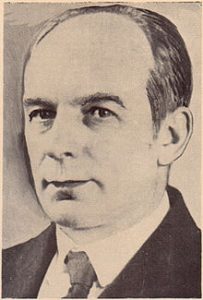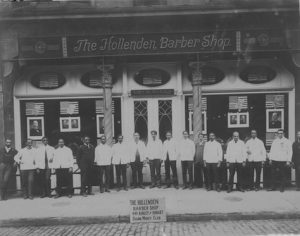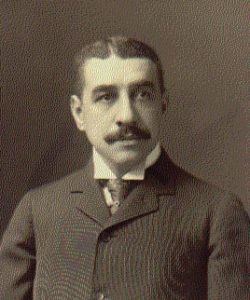
Charles Ruthenberg 1924 (wiki)
The pdf file is here
WHEN CLEVELAND SAW RED
By John Vacha
Along with the rest of the country, Clevelanders were shocked on the evening of September 6, 1901, to learn that President William McKinley had been shot in Buffalo, New York. What brought the news closer to home than elsewhere, however, was the knowledge soon to follow that the man who had fired the fatal bullet had been a resident of their own city. Leon Czolgosz was the son of Polish immigrants living in Cleveland’s Warsawa district on the southeast side.
A reporter from the Cleveland World tracked down the assassin’s father on Fleet Avenue. He had once run a neighborhood saloon, where a group of anarchists was said to have met in a hall above the barroom. “I think he is insane,” said Paul Czolgosz of his son. “I don’t think he is an anarchist. He is, I believe, a member of the Socialist Labor Party, but of no other organization.”
In fact, the younger Czolgosz had once been rebuffed in his attempt to join a local anarchist society and was a classic example of the loner in the history of American assassinations. Then as now, however, conspiracy-minded Americans were prone to associate foreigners and immigrants indiscriminately with such European political movements as Anarchism, Communism, and Socialism.
Even native-American politicians were not immune from such suspicions. Tom L. Johnson, Cleveland’s great reform mayor, may have been “the best Mayor of the best governed city in the United States” in the eyes of muckraker Lincoln Steffens, but businessman Mark Hanna saw Johnson as a “socialist-anarchist-nihilist.” Most of Johnson’s reforms happened to be as American as apple pie: paving and cleaning the streets, removing “Don’t Walk on the Grass” signs from city parks, building municipal bath houses, and instituting a city purchasing department to eliminate waste and corruption. The closest he carne to socialism was in his campaigns to establish municipal ownership of electric power and street railways. That was enough for conservatives like Hanna, whose antipathy couldn’t have been allayed by the sight of the mayor campaigning in a Winton automobile known as the “Red Devil.”
Tom Johnson was mayor of a city of 381,768 residents in 1900, one third of whom were foreign-born and three quarters of whom were either foreign-born or children of the same. Two thirds of the city’s working class were engaged in construction, manufacturing, and service trades, most of them was skilled or semi-skilled laborers. They lived in working-class neighborhoods dominated by up-and-down double or front-and-back-yard single houses. Many if not most still lacked indoor plumbing–hence the need for public baths. Working conditions were even more primitive than housing conditions, marked by low wages (15 to 25 cents an hour), long hours (10 to 12 per day), child labor, and sweatshop standards. Employers resisted workers’ efforts to organize for better conditions by the use of company spies, strikebreakers, and blacklists against workers involved in unionizing activities.
Two approaches were available for those workers who persisted in attempting to organize: the traditional craft unions of the American Federation of Labor or the class-oriented Socialist Labor Party. Labor unions sought to achieve their goals through collective bargaining with employers or government legislation, while Socialists sought broader reforms through the replacement of capitalism by a workers’ government that would take over and operate the major means of production.
While native-American workers tended to favor trade unions, and immigrants were more comfortable with socialist organizations from their European experience, there was a considerable overlap between the two approaches. Max Hayes, a native-born American printer, for example, was secretary of Cleveland’s Central Labor Union as well as a member of the Socialist Party of America. He co-founded and edited the official organ of the Central Labor Union, the Cleveland Citizen, and ran for Congress and Ohio Secretary of State on the Socialist ticket. He regarded unionism as his primary allegiance, however, and believed that socialists should work for reform through unions and the existing political system.
A major test for Cleveland’s union movement came with the garment workers’ strike of 1911. It started on June 6, when 5,000 Cleveland garment workers walked off the Job, only three months after 135 New York workers had died in the Triangle Shirtwaist fire. Cleveland’s garment industry ranked fourth in the nation, and the International Ladies Garment Workers Union viewed it as a potential model for organization. Their demands included a fifty-hour work week with a half holiday on Saturdays and no more than two hours overtime a day, abolition of sweatshop conditions, and a raise in pay.
Garment manufacturers matched their striking employees in a display of solidarity. Refusing to negotiate with union representatives or agree to arbitration, the owners kept their businesses in operation by bringing in strikebreakers and sub-contracting with out-of-town plants. Strikers organized parades to promote their cause, including a march through the downtown business district by two female locals. The manufacturers countered by hiring agents to infiltrate the unions and incite members to violence. Told by one of these that their tactics were “too lady-like,” female strikers responded by assaulting scabs and police with their purses and fists, thereby turning public opinion against the strike. After five months, the strikers returned to work with none of their demands gained.
Such experiences undoubtedly prompted workers, especially those of recent European background, to consider socialistic solutions to the labor question. An estimated four out of five male workers, and two of five female employees, in Cleveland’s garment industry were foreign-born. When Charles Ruthenberg was ready to Join the Socialist Party in 1909, he found only eight English speaking locals in the city, as against eighteen of various nationalities, led by the Germans, Czechs, and Poles.
The son of German immigrants, Ruthenberg had begun his political odyssey as a supporter of Tom L. Johnson. Though still a believer in the free enterprise system, he was against special privilege and in favor of the mayor’s campaign for municipal ownership of the city’s street railways. Ruthenberg was not a laborer or tradesman but a white collar worker. Even before Johnson’s defeat in 1909, however, he was rapidly moving in the direction of socialism. Asked much later for the cause of his conversion, he replied, “Through the Cleveland Public Library.” When Eugene V. Debs, the most prominent socialist in America, spoke at Grays Armory in 1911, brochures listing the library’s holdings on socialism were distributed to those in attendance. Ruthenberg became recording secretary of Cleveland’s Socialist Party and within two years was running for mayor against Newton D. Baker and earning a respectable 8,145 votes.
It was a time fermenting with change, for socialists as well as progressives in general. Early in 1912, a state constitutional convention proposed no fewer than forty-one amendments to the Ohio constitution, last revamped in 1851. Voters approved thirty-three of them, including the great ballot reforms of initiative and referendum. Equally important for cities such as Cleveland was passage of a “home rule” amendment granting cities greater control over ways of addressing some of the unique problems of urban life. It had been drafted largely by Cleveland’s new mayor, Newton D. Baker, who promptly set about promoting the adoption of a new city charter.
Baker also played a prominent role in the Presidential election of 1912. At the Democratic National Convention he gave an impassioned speech from the floor which led to the overturning of the constitution’s unit rule, thus releasing nineteen of Ohio’s delegates to vote for the eventual nominee, Woodrow Wilson. A split in the Republican party between supporters of President William H. Taft and former President Theodore Roosevelt virtually guaranteed Wilson’s election. So great was Baker’s dislike of Roosevelt that he expressed a preference for Eugene Debs, the Socialist candidate. In an unscientific exit poll of Cleveland theatergoers taken by the Cleveland Press, Debs actually outpolled Taft, finished third behind Wilson and Roosevelt. Wilson carried Ohio in the general election, but Debs picked up an impressive 89,930 votes in the state, a tenth of his national total of 900,000. Ruthenberg, the Socialist candidate for governor, was close behind with 87,709 votes. The party’s statewide appeal was much wider than its 3,500 dies-paying members, gaining Ohio a national reputation as the “Red State.”
Ethnic groups remained the core of the Socialist Party, especially in multi-cultural Cleveland. Many of their meetings took place in the old Germania Hall, rechristened Acme Hall when the original tenants, the Germania Turnverein, left in 1908 for newer quarters. On the west side, Socialist meetings were often called to order in a hall built by the Hungarian Workingmen’s Singing Club on Lorain Avenue. One Hungarian woman recalled passing the hat there for Socialist contributions following a Ruthenberg speech. Ruthenberg was often the featured English-speaker of the night at these gatherings, appearing at them often several nights a week. He would later observe that the best working-class daily newspapers in America all happened to be printed in foreign languages. One was the Americke Delnicke Listy (American Daily News), located in Cleveland’s Czech neighborhood on the southeast side. During the garment strike it had attempted to discourage strikebreakers by printing their names and addresses.
When war clouds gathered over Europe in 1914, Cleveland’s socialists turned May Day into an antiwar demonstration, marching through Public Square and rallying that evening in Acme Hall. War indeed broke out that August, and 3,000 socialists showed up in the rain for an antiwar protest in Wade Park. Though confined as yet to Europe, the First World War presented serious issues for American socialists, particularly those of foreign extraction. As socialists they were opposed to all wars as manifestations of capitalist rivalries. To the various Slavic and Magyar nationalities within the socialist movement, however, the war offered the promise of liberating their cultural homelands from German, Austrian, or Russian domination.
As events pushed America closer to participation, the war became more than an academic question f or American socialists and workers. Ruthenberg and the socialists campaigned against American entry right up to the eve of President Woodrow Wilson’s war message to Congress. They scheduled a stop-the-war meeting f or April 1, 1917, at Grays Armory, only to find the doors locked upon their arrival. Undampened, Ruthenberg led them in the rain to register their protest on Public Square.
For workers of all political persuasions, the war offered the benefit of high employment. Taking advantage of the wartime labor shortage, the garment workers again went on strike in 1918. The manufacturers this time agreed to submit the dispute to arbitration, but only at the urging of Secretary of War Newton Baker, former Mayor of Cleveland, who wanted to insure the supply of military uniforms. The workers not only won a substantial raise but secured union recognition in Cleveland’s men’s clothing industry.
America’s socialists found the government far less tolerant of their political activities. Foreign-born citizens, especially those from enemy countries, saw their loyalties under suspicion. An Americanization Board was established in Cleveland by the Mayor’s Advisory Committee to teach English to foreign-speaking aliens and to encourage them to become naturalized American citizens. Max Hayes and the moderate branch of the Socialist Party in general supported America’s participation in the war.
Charles Ruthenberg had become the recognized leader of the Socialist Party’s left wing. Even after America’s declaration of war against the Central Powers, he and other socialists continued to speak out against the war and the military conscription act. Given the choice between dropping his political activities or losing his position as office manager in one of Cleveland’s leading garment makers, Ruthenberg turned down a $5,000 raise and $10,000 stock offer to work full time for socialism. Alfred Wagenknecht, state secretary of the Socialist Party, was arrested at an antiwar meeting on Public Square, near the statue recently dedicated to Tom L. Johnson and free speech. (Years earlier, when the notorious anarchist Emma Goldman had come to town and dared Johnson to stop her from speaking, the mayor had invited her to have her say on Public Square.)
Ruthenberg and Wagenknecht were soon charged with obstructing the Conscription Act and sentenced to a year in the workhouse in Canton, Ohio. Even under sentence, Ruthenberg was on the ballot for mayor and received 27,000 votes, more than a quarter of the votes cast. Two Socialists were elected to the city council and another to the board of education in that election, though the board member was subsequently prosecuted under the Espionage Act and removed from office.
Eugene Debs came to Canton in 1918 to address the Socialist Party’s state convention. After visiting Ruthenberg in the workhouse, he went to the park across the street to deliver a fiery antiwar speech to a thousand supporters and a couple of note-taking government agents. Two weeks later, Debs was arrested as he arrived in Cleveland to speak at a socialist gathering at the Bohemian Gardens on Clark Avenue. He was tried for violating the Espionage Act in the U.S. District Court in downtown Cleveland and sentenced to the federal penitentiary in Atlanta, Georgia. Following Ruthenberg’s example, he ran for President in 1920 and pulled in nearly a million votes from behind bars.
Despite such moral victories, socialism in the United States never recovered from the hysteria of World War I. The Bolshevik Revolution of 1918 in Russia brought hope to socialists everywhere, but fear and alarm to their enemies. Although fighting ended in November, 1918, wartime passions still burned fiercely in America, which had entered the conflict so belatedly. There were race riots in twenty-three American cities in 1919, fueled by the urban incursion of African Americans in search of wartime Jobs.
Cleveland had its own riots that year, but the targets were reds, not blacks. Some 30,000 socialists and their sympathizers gathered as usual on May 1 for the annual May Day observance. From various starting points they marched towards Public Square, where Ruthenberg was to deliver the oration of the day. Tens of thousands more lined the streets to watch, not all of them sympathetic. As the columns, Ruthenberg at the head of one, reached the more crowded downtown streets, onlookers began to attack the marchers, trying to snatch their red flags and break up their ranks. Among the attackers were army veterans, patriotic vigilantes, and, by some accounts, the police themselves. Two people were killed, scores sent to hospitals, and more than a hundred arrested, most of them marchers.
Officially, the May Day Riots were blamed on the socialists, who carried such “provocative” banners as “Workers of the World, Unite!” Even Max Hayes blamed the riots on incendiary statements by Ruthenberg. The city banned the red flag and talked of purchasing six tanks for riot control. Ruthenberg was arrested for “Assault with intent to kill,” a charge which was later dismissed.
Later accounts generally saw the marchers as the victims of mob action, spontaneous or even organized. “I saw a peaceable line of unarmed paraders attacked on an obviously preconcerted signal,” Cleveland Plain Dealer columnist Ted Robinson would write years later. “I saw men and women brutally beaten…. I saw the blood flow in sickening streams at the city’s busiest corner; I saw the victims arrested while the attackers went free; and I saw the fining and Jailing of these victims on the following day.”
By the end of that year, Ruthenberg had led the radical wing of socialists into the formation of the Communist Party of the United States. He became the party’s general secretary and spent his remaining years either organizing or fighting and serving prison sentences on such charges as advocating the violent overthrow of the government. At the age of 44, he died of peritonitis following a ruptured appendix in Chicago in 1926. His ashes were taken to Moscow, where he joined John Reed and Bill Haywood as the only Americans interred in the Kremlin.
It was largely the reaction of the Red Scare that prompted the United States to impose immigration quotas following World War I. Such legislation, and the illusory prosperity of the “Roaring Twenties,” checked the appeal of socialism in America. Not even the Great Depression could restore it to the strength it had demonstrated in Cleveland and other urban centers in the first two decades of the twentieth century.
To read more about Charles E. Ruthenberg and socialism in Cleveland, click here




